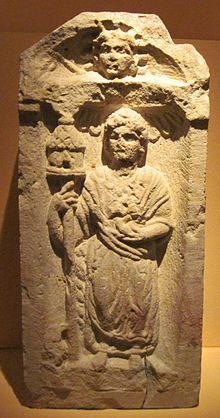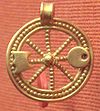- Nantosuelta
-
In Gaulish religion, Nantosuelta was a goddess of nature, the earth, fire, and fertility. The Mediomatrici (Alsace, Lorraine) depicted her in art as holding a model house or dovecote, on a pole (a bee hive). Nantosuelta is attested by statues, and by inscriptions. She was sometimes paired with Sucellus. Nantosuelta was also the Goddess of Nature in Lusitanian mythology[citation needed]. In addition, her symbol the raven symbolized her connection as a goddess of the dead.[citation needed]
Contents
Depictions
In this relief from Sarrebourg, near Metz, Nantosuelta, wearing a long gown is standing to the left. In her left hand she holds a small house-shaped object with two circular holes and a peaked roof. Her right hand holds a patera which she is tipping onto a cylindrical altar.
To the right Sucellus stands, bearded, in a tunic with a cloak on his right shoulder. He holds his mallet in his right hand and an olla in his left. Above the figures is a dedicatory inscription and below them in very low relief is bird, of a raven. This sculpture was dated by Reinach (1922, pp. 217–232), from the form of the letters, to the end of the first century or start of the second century.
An altar from Metz has a carving of a woman with similar dress to the Sarrebourg example, also holding a small house on a pole, thus presumed to be Nantosuelta. Sucellus is not shown on this example.
She was associated with the cornucopia.[citation needed]
Inscriptions
The inscription (Jufer & Luginbühl p. 129) on the Sarrebourg altar (CIL XIII, 4542) reads:
- Deo Svcello /
- Nantosvelte /
- Bellavsvs Mas /
- se Filivs V(otum).S(olvit).L(ibens).M(erito)
To the God Sucellus and to Nantosuelta, Bellausus, son of Massa, willingly and deservedly fulfilled his vow.
The inscription on the Metz altar (AE 1896, 0049) says:
- In h(onorem) {r} d(omus) d(ivinae) /
- M(arcus) Tignuarius /
- v(otum) s(olvit) l(ibens) m(erito)
Here the dedication is to the Imperial house, and Nantosuelta is not explicitly mentioned. The visual depiction makes the identification secure.
Etymology
Delamarre asserts that the name means ‘sun-warmed valley’ [1]. Roux in 1952 [2], Olmstead in 1994 [3] and Polomé in 1997 [4] maintained that the proto-Indo-European root *swel- ‘swelter’, found in Indo-European words denoting ‘sun’, was inherited into Gallic.
References
- ^ Delamarre, X. (2003). Dictionnaire de la Langue Gauloise. 2nd edition. Paris, Editions Errance. ISBN 2-87772-237-6
- ^ Le Roux (1952) "Le soleil dans les langues Celtiques." Ogham 4, p. 93
- ^ Olmstead, G. (1994) The Gods of the Celts and the Indoeuropeans. Innsbrucker Beiträge zur Kulturwissenschaft-Archaeolingua, Sonderheft 92.
- ^ Polomé, E. C. (1997) Zeitschrift für celtische Philologie, 49-50.
- Année Epigraphique, volume 1896.
- Centre for Advanced Welsh and Celtic Studies. Proto-Celtic—English lexicon. University of Wales. (See also this page for background and disclaimers.)
- Corpus Inscriptionum Latinarum (CIL), volume 13, Tres Galliae.
- Delamarre, X. (2003). Dictionnaire de la Langue Gauloise. 2nd edition. Paris, Editions Errance. ISBN 2-87772-237-6
- Deyts, S., Ed. (1998) A la rencontre des Dieux gaulois, un défi à César. Paris, Réunion des Musées Nationaux. ISBN 2-7118-3851-X
- Jufer, N. and T. Luginbühl (2001) Répertoire des dieux gaulois. Paris, Editions Errance. ISBN 2-87772-200-7
- Le Roux (1952) "Le soleil dans les langues Celtiques." Ogham 4, p. 93.
- Olmstead, G. (1994) The Gods of the Celts and the Indoeuropeans. Innsbrucker Beiträge zur Kulturwissenschaft-Archaeolingua, Sonderheft 92.
- Polomé, E. C. (1997) Zeitschrift für celtische Philologie, 49-50.
- Porkorny, Julius (1959) Indogermanisches etymologisches Wörterbuch Berlin: Franke Verlag
- Reinach, S. (1922) Cultes, mythes et religions.
External links
- Le musée de Liffol-le-Grand has a reconstructed shrine to Nantosuelta
Celtic mythology series Ancient deities of Gaul, Britain and Gallaecia by region Supra-regional Alaunus • Alisanos • Andarta • Anextiomarus • Artio • Aveta • Belenus • Belisama • Borvo • Brigantia • Camulus • Cernunnos • Cicolluis • Cissonius • Condatis • Damona • Matrona • Dis Pater • Epona • Erecura • Esus • Genii Cucullati • Grannus • Ialonus Contrebis • Lenus • Litavis • Loucetios • Lugus • Maponos • Matres • Mogons • Nantosuelta • Ogmios • Rosmerta • Segomo • Sirona • Sucellus • Suleviae • Taranis • Toutatis • Virotutis • VisuciusBritannia Gallia Aquitania Gallia Belgica Abnoba • Ancamna • Arduinna • Arvernus • Icovellauna • Inciona • Intarabus • Iovantucarus • Ritona • Veraudunus • Vindonnus • Vosegus • XulsigiaeGallia Celtica Gallia Cisalpina Gallia Narbonensis Germania Inferior Gallaecia Categories:- Earth goddesses
- Fire goddesses
- Fertility goddesses
- Ancient Gaulish and British goddesses
- Celtic goddesses
- Nature goddesses
Wikimedia Foundation. 2010.




